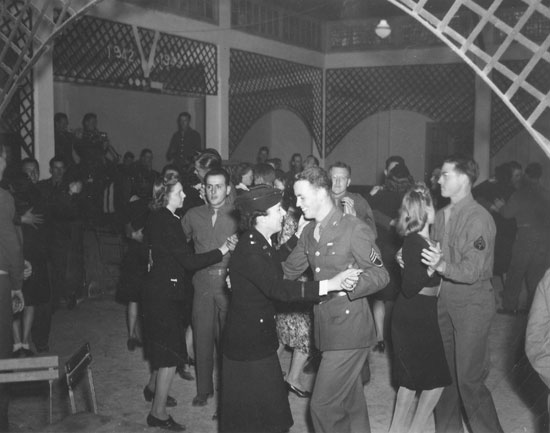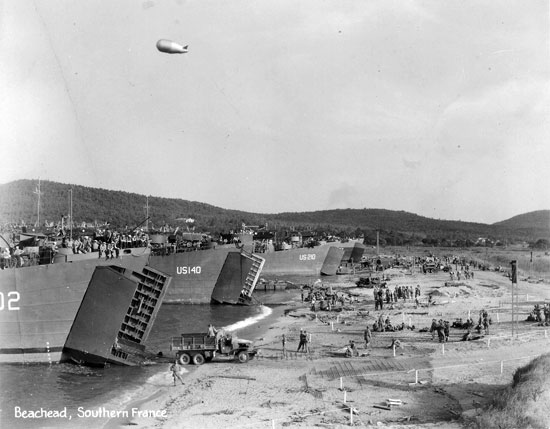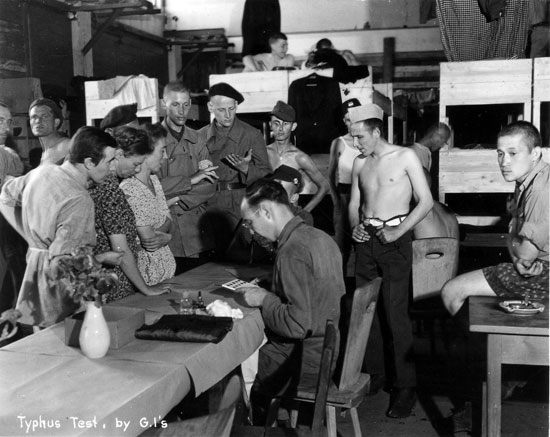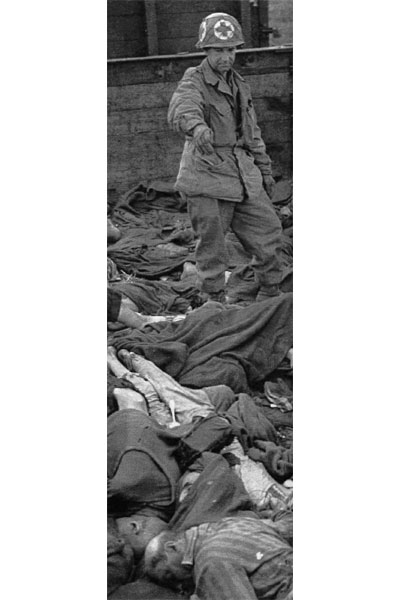Veteran’s Testimony – George P. McLaughlin 59th Evacuation Hospital

Picture illustrating some members of the 59th Evacuation Hospital during their assignment overseas.
Back row from L to R: T/Sgt Lars Steinnes, T/4 Robert Spring (photographer), Pvt Volpone, Pvt Corradine, Pvt Walter Funk, T/5 Johnson.
Front row from L to R: Pvt Thomas Bowler, T/5 George McLaughlin, Capt Cyril Johnson, Capt Robert Treadwall
Introduction:
Here follow some notes and pictures relating to the 59th Evacuation Hospital received from Mrs. Joanne McLaughlin, following her correspondence with the MRC Staff, and reproduced here with her kind permission.
My father’s name is George P. McLaughlin, he was born on 12 April 1920 in Cohasset, Massachusetts, U.S.A. and was inducted into the Army of the United States 10 January 1942 at Ft. Devens, Ayer, Massachusetts (Military Reservation). His Army Serial Number was 31026229, and the highest grade he ever held was that of Tec 5 (Technician 5th Grade).
Assignments & Training:
After induction, my father was sent to Ft. Riley, Junction City, Kansas, and since this Post was a Cavalry Replacement Training Center and School, he joined the Cavalry and became responsible for exercising the horses. Ft. Riley was a crowded place spread over an acreage of 54,183 and with a troop capacity of 3,078 Officers and 32,907 Enlisted personnel. Trooper George McLaughlin probably served in one of the last Mounted units in the United States Army (perhaps, the 2d Cavalry Division, inactivated 15 July 42, at Ft. Riley) as the Chief of Cavalry Office was eliminated in March 1942, before being transferred to the 59th Evacuation Hospital. At some point I believe he also spent some time at Ft. Ord, Monterey, California (Army Ground Forces Training Area with an acreage of 38,690, and a troop capacity of 51,253 Enlisted personnel).

Enjoying the New Year’s Dance Party, and celebrating the end of 1942 in Casablanca, French Morocco.
This 750-bed Hospital, which had been activated on 6 April 1942, was affiliated with the San Francisco Hospital, San Francisco, California. One of the methods introduced by The Surgeon General to accelerate the expansion of the Medical Department, was to assist in the formation and organization of medical units affiliated with civilian Hospitals or Schools. Apart from its complement of Medical Officers (36) from the San Francisco Hospital, including mostly Stanford University and University of California Medical School graduates, the new unit was trying to fill its current T/O by transferring a number of Enlisted Men from other military Hospitals, and receiving a number of additional Inductees and Trainees.
After having gone through the required specialized training, my dad became an X-Ray Technician (MOS 264) with the 59th. If my memory serves me right, Col. Carleton Mathewson, a graduate from the University of California and Stanford Medical School became the very first CO of the 59th Evacuation Hospital in spring of 1942.
A good friend of my father, and also a Technician serving with the Hospital unit was Robert Spring. This soldier kept a 35mm camera and would go out together with my dad to shoot pictures, this explains why George McLaughlin appears in quite many pictures. They would set out together, and Spring would later sell the photos to my dad and other GIs for a dime. As a matter of fact, some of those pictures have turned up for sale on the internet, they are easy to recognize since they all have identical inscriptions, and many are in my dad’s collection. As both of the men were X-Ray Technicians, the photographer and my father would develop the pictures, and add a short caption to every print.

Treating a battle casualty with an X-Ray Machine. Second from left, observing the process stands Technician George P. McLaughlin.
Portable field units enabled the taking of X-Ray pictures at a patient’s bedside.
There are several photographs illustrating the Hospital unit and its personnel, sometimes describing Technicians at work with the portable X-Ray machine, and some taken of friendly and/or enemy patients. Some of the images are truly impressive, particularly those shot later in the war, describing German Prisoners of War, in fact rather young kids. Other photos further include GIs on troop transport ships on their way to Sicily and Southern France. Some truly exceptional pictures were taken at the TB Wards of the Dachau Concentration Camp, after the Camp was liberated by US Forces.

Enjoying K-Rations during chow time on board one of the LSTs, part of the 59th Convoy en route for Palermo, Sicily, where it arrived on 6 Aug 43…
The 59th Evac Hosp initially served in North Africa, operated on the island of Sicily, landed in Italy, served in Southern France, from the Riviera to the Moselle, and finally transferred to the European Theater, where it would lend the Seventh US Army some of the necessary medical support during the fighting in Germany.
The 59th Evac Hosp participated in different campaigns, for which it received due credits. Campaigns included: Sicily (9 July 1943 > 17 August 1943), Rome-Arno (22 January 1944 – 9 September 1944), Southern France (15 August 1944 – 14 September 1944).

Hold of USAT “Uruguay” which carried the Hospital unit to North Africa, note crammed quarters on board. The person sitting at the top left of the image (reading a book) is Tec 5 George McLaughlin.
North Africa:
The Hospital embarked for the Mediterranean Theater of Operations (NATOUSA) on 12 December 1942; it arrived in Casablanca, French Morocco 24 December 1942, where it spent its first overseas Christmas under canvas! Other Hospital units of the Western Task Force to reach western Morocco were the 8th Evacuation Hospital, the 11th Evacuation Hospital, later joined by the 91st Evacuation Hospital. Six days later, the 59th was fully operational and received its first patients. This is the place where the medical personnel learned and suffered a lot – water was scarce, sanitation was primitive, malaria, dysentery, and high fevers were widely prevalent, and all of these factors had to be taken into account in medical preparations. While in North Africa, the unit was attached to Major General George S. Patton’s Third United States Army for “Operation Husky”, the Invasion of Sicily. The 59th would be joined by other medical units such as:
- 11th Evacuation Hospital
- 15th Evacuation Hospital
- 91st Evacuation Hospital
- 93d Evacuation Hospital
- 128th Evacuation Hospital
- 4th Field Hospital
- 10th Field Hospital
- 11th Field Hospital
Sicily:
After the necessary field training and initial medical operations, the unit transferred to Sicily. It landed at Palermo on 6 August 1943, and temporarily joined the 91st Evacuation Hospital in the University of Palermo, Polyclinic Hospital, in which buildings it operated, because much of the equipment was still at sea and therefore the Hospital couldn’t be made fully operational, although it started limited operations on 8 August. During the entire period spent on Sicily, the unit closely operated with the 34th Station Hospital (also in Palermo) under overall command of Island Base Section (IBS), which was to close down 15 July 1944.
Dad told a story about how General Patton rolled into the Hospital one day – he came up to my father, who was not dressed to Patton’s liking. My dad said, he knew enough to salute (nothing got past him), then the General demanded to see the CO, Patton found the Commanding Officer who was also not dressed to his liking, and they all got chewed out! He also mentioned that Patton was treated by a doctor in his unit…

22 Aug 44, partial view of the 59th Evac Hosp Convoy on its way to France. Picture taken by Robert Spring while on board an LST bound for St. Tropez, southern France.
Italy & Southern France:
When the Fifth United States Army was activated, i.e. on 5 January 1943, the 59th Evac Hosp was already listed to be attached to this formation for medical support during “Operation Avalanche” (together with the 8th – 9th – 11th – 38th – 77th – and 91st Evacuation Hospitals and the 47th Surgical Hospital). The Hospital however, only shipped out to Anzio Beachhead on 7 June 1944 (after “Operation Shingle” and after the fall of Rome), to serve under Peninsular Base Section (PBS). It first replaced the 38th Evacuation Hospital which shifted to Rome, and later dug-in its Ward tents on the dangerous Beachhead area itself, together with other American units. After July, the 59th transferred to Battipaglia, in southern Italy, where the Seventh United States Army was now training for “Operation Dragoon”, the Invasion of southern France. It finally landed in France 25 August 1944, and first set up in the coastal region in support of VI Corps. It would then follow the advance of the Army Divisions proceeding further inland…

Open view of Beachhead with rows of LSTs, near St. Tropez, southern France, where the 59th Evac Hosp landed on 25 Aug 44.
Later in the war, my father talked about the nature of the wounds he treated. When they reached more forested areas, like around Epinal, he explained that because of the trees, artillery shells would explode higher up, and consequently lots of patients had head wounds due to tree bursts. They also were perplexed when they started treating German PWs, discovering that many of the enemy veterans had metal pins and screws in their legs and arm bones. Until then, it was not heard of to set bones that way, and the Army doctors made a big deal about it.
When in Germany, George McLaughlin once literally ran into a lonely German soldier who made it clear he wanted to surrender! My father brought him to an Officer, who commented that it would have been a good idea to take the gun away from the prisoner! My father said that, in retrospect, he fully agreed (he would have brought the gun home as a souvenir).
Locations & Field Stations of the 59th Evacuation Hospital
- Casablanca, French Morocco – 30 Dec 42 > 30 Jun 43
- Palermo, Sicily – 8 Aug 43 > 6 May 44
- Anzio, Italy – 7 Jun 44 > 10 Jul 44
- Battipaglia, southern Italy – 16 Jul 44 > 27 Jul 44
- Ste. Maxime, southern France – 25 Aug 44 > 27 Aug 44
- Carpentras, southern France – 28 Aug 44 > 5 Sep 44
- Rioz, France – 17 Sep 44 > 30 Sep 44
- Epinal, France – 5 Oct 44 > 30 Nov 44
- Mutzig, France – 8 Dec 44 > 30 Dec 44
- Epinal, France – 1 Jan 45 > 23 Jan 45
- St. Avold, France – 16 Mar 45 > 24 Mar 45
- Grünstadt, Germany – 26 Mar 45 > 31 Mar 45
- Tiefenthal, Germany – 1 Apr 45 > 19 Apr 45
- Crailsheim, Germany – 25 Apr 45
- Schnaitheim, Germany – 26 Apr 45 > 3 May 45
- KZ Dachau, Germany – 10 May 45 > 12 Jun 45
- Ellwangen, Germany – 1 Aug 45 > 31 Aug 45
Germany – Dachau:
On 10 May 1945, the CO of the 59th Evacuation Hospital was assigned as Camp Surgeon of KZ-Dachau (Dachau Concentration Camp). A group of senior Officers, the Hospital Dietitian, and about 20 Enlisted Men were detailed to assist the staff. Later on, 8 Nurses were placed on Detached Service to work on the Typhus Ward (run by the US Typhus Commission).

American doctors are carrying out Typhus tests, in order to try and control any further outbreak. Tests are run in renovated and cleaned barracks housing former Dachau inmates. Picture taken early May 1945.
Following Officers were assigned to the Dachau Camp Surgeon’s Office:
| Colonel Oral B. BOLIBAUGH, MC, O-4179 | Chief Surgeon |
| Lt. Colonel Roy B. COHN, MC, O-400120 | Executive Officer |
| Major John S. BROWN, MC, O-400829 | Medical Consultant &Advisor Food & Dietetics |
| Major Gilbert A. BISHOP, MAC, O-1533259 | Medical Supply Officer |
| Captain Nelson C. BELL, MC, O-313454 | Sanitary Officer |
| Captain William C. KUZELL, MC, O-447772 | Officer in Charge of Outer Camp Hospital |
| Captain William A. NEWSOM, MC, O-446992 | Chief Professional Service Outer Camp Hospital |
| Captain Charlton R. SCHWARTZ, MC, O-400122 | Dispensary Outer Camp Hospital |
| Captain John M. MALONE, MC, O-474102 | Assistant Dispensary Outer Camp Hospital |
| Captain Peter S. JOSEPH, MC, O-400471 | Officer in Charge Convalescent Hospital, Bldg #24 |
| Captain Rene BINE, Jr., MC, O-439518 | Officer in Charge Convalescent Hospital, Bldg #24 |
| 1st Lieutenant Henriette H. DICKINSON, R-238 | Hospital Dietitian |
The first frenzy of joy with the Liberation of the Dachau Concentration Camp on 29 April 1945 by the 42d Infantry Division (some pretend it was the 45th Infantry Division) was accompanied by unrestricted looting and wanton destruction. Available foodstores were plentiful for a short time, but with freedom, came unrest, and by what appears to be an almost superhuman effort, an International Prisoners’ Committee was set up by a mixed group of American – British – Canadian – Belgian Officers, to restore order and try and organize the camp. Work details had to be organized, hospitalization made available, kitchen crews appointed, food distribution arranged, and enough organization built up to allow the US Army Typhus Commission to arrange for vaccination and DDT dusting teams to treat the former inmates. Personnel from the 66th Field Hospital reached one of the Dachau subcamps on 30 April, and would later also provide medical support, and several Seventh US Army trucks arrived with food and medical supplies the same day.
The 116th and 127th Evacuation Hospitals, on site, began receiving patients on 4 May.

Partial view of the TB Ward set up by Seventh US Army Hospitals to treat former inmates of the Dachau Concentration Camp.
By 9 May, the first series of vaccinations and dusting were completed, and box cars filled with bodies, as well as most bodies lying about the inner compound had been removed for cremation and burial. Cleaning of the other buildings and sorting of healthy and sick people had meanwhile started. On 16 May, six Nurses from the 59th arrived and began their duties at the special Typhus Ward (run by the 116th Evac Hosp), a special clinical facility of 64 beds, until 30 May. The Ward itself was closed 9 June 1945, and treated male patients of various nationalities ranging between 17 and 58 years.

Somewhere in Germany, delousing liberated Russian PWs (although this is the original caption, there is some doubt about the true identity of those ‘Russians’, in view of the uniforms they are wearing, the picture might have been taken elsewhere as well)
As soon as the Medical Department had sufficient personnel to carry out the task of Hospital organization, full use was made of it, including integration of the medical profession amongst former inmates to establish various national Dispensaries varying from 20 to 150 beds. These acted as a filter for a Camp Dispensary, which in itself acted as another filter for the Army Hospitals. At one time, the Medical Department had 6 Hospitals at its disposal with a total bed capacity of 7180. Administration was further complicated by the necessity to maintain a quarantine for Typhus fever! As PW labor became available about 16 May, the camp organization became fully functional. The evacuation process gathered speed and more beds became available; subsequently, the Camp Hospitals, the Field Hospitals, and the inner compound Hospitals were gradually closed. The TB Ward was the last to close. The doctors at Dachau would not let most of the X-Ray section go into the camp itself because of the Typhus outbreak. But as the medical authorities needed to record both the Typhus and TB epidemics, they brought Robert Spring, the photographer in, to document their findings.

Dachau survivors greet their US liberators. Units of the Seventh US Army liberated the Camp on 29 April 1945.
Photograph : Private Collection.
My dad was glad that his unit was always pretty much behind the front lines, except once in Europe, when the 59th had moved so fast, they had set up behind the Germans…

A Seventh US Army medic points at one of the corpses left to die in an open boxcar. Nearly 32,000 inmates of Dachau were liberated.
On 23 Apr 45 2,340 Jews were grouped and thrown into open boxcars for evacuation, but there was no locomotive, and the prisoners remained in the same boxcars without neither food nor water for three days and nights. By 26 April, over 700 had died. Moreover a Typhus outbreak (since Dec 44) was gradually killing additional inmates… this was part of the horror of Dachau.
Photograph : Private Collection.
George P. McLaughlin, Tec 5, 59th Evac Hosp, US Army, ASN 31026229, left the Army at Camp Edwards “Separation Point SCU 1”, Massachusetts, the date was 12 October 1945. His ASR Score (2 Sep 45) was 94. My father’s decorations included the Army Good Conduct Medal, and the European-African-Middle Eastern Theater Campaign Ribbon with 5 Service Stars. He officially participated in following Campaigns: Sicily, Rome-Arno, Southern France, Rhineland, and Central Europe, and served 11 months and 7 days in the Zone of Interior and spent 2 years, 9 months, and 26 days overseas.

Tec 5 George P. McLaughlin, ASN 31026229, 59th Evac Hosp
Unless otherwise stated, all above images are courtesy of Joanne McLaughlin, and belong to the collection of Tec 5 George P. McLaughlin (ASN: 31026229). The photographer is Robert Spring. Both soldiers were X-Ray Technicians serving with the 59th Evacuation Hospital.
